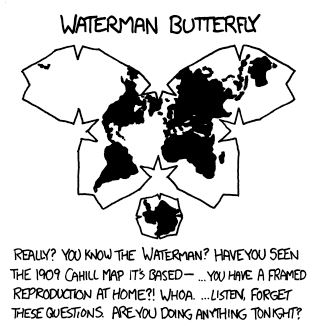

If there are three players present I’ll run. Unless there is something big upcoming, then we’ll discuss if we want to postpone. I usually say “I want four players, so I’ll recruit to five, and run with three”.


If there are three players present I’ll run. Unless there is something big upcoming, then we’ll discuss if we want to postpone. I usually say “I want four players, so I’ll recruit to five, and run with three”.


I’m in a similar boat. According to steam haven’t opened EUIV since 2017 and now I have a huge relearning curve. And new DLC to get. While I would love to get back into it I have better (path) things (of) things (exile) to (two) do.


Inkscape enjoyer here. The vector based tech makes it not that limited to my skill at drawing but rather how I can manipulate the vectors and points. Make things thinner or wider, change a curvature etc. And nothing is set in stone. I’m using it for everything. World maps, region maps, settlements, dungeons. You name it. For dungeons (and inside locations) I gathered all my most used assets to save time.


Most recognizable trigger from said image - Reinstalling EUIV
Sigh… here I go again…


“New to me” it may technically be but I’m going to start up something with Ironsworn: Starforged: Sundered Isles (yes I’m calling it that, fight me). Have used both Ironsworn and Starforged before but not Sundered Isles.
What actually would be new to me is Fey Borg as I’ve yet to run anything Borg. Barely anything OSR at all.
Shawn Tomkin’s Ironsworn series. Delve I regularly use for setting up point crawls. Ironsworn/Starforged/Sundered Isles have great collections of random tables, I use the book thematically most fitting for the situation at hand. The core tables of Action, Theme, Descriptor and Focus all get heavy use.
Kevin Crawford’s [SOMETHING] Without Number series have awesome tables as well. These however get more use when I need more detail. Prep stuff. Again most thematic book is picked first but I do have used Cites (cyberpunk) for fantasy cities.
When I want to create background for “medieval fantasy” characters I pick up Burning Wheel and burn something up. Through that I get a good selection of relevant skills to sue (for flavor)
Anything related to cosmos and mythology I say HELLO! to my growing collection of Glorantha material. From cult books to magic tomes and Atlases.
So many. And the answer to all “why nots?”. Time. It’s time. So off the top of my head
Eat the Reich - “The year is 1943. You are a team of crack vampire commandos with one mission: drink all of Hitler’s blood”
Conan 2d20
Legend of the Five rings (5e)
Stoneburner - Deep Rock Galactic the TTRPG
Vaesen - Call of Cthulhu but rooted in nordic mythology
Heart the City Beneath - an award-winning complete tabletop roleplaying game about delving into a nightmare undercity that will give you everything you’ve ever dreamed of – or kill you in the process.
Depends on the system. Classical fantasy adventuring? Most if not all sessions. Adventure and Sword&Sorcery? Sometimes, half perhaps. Character drama? Very seldom.
I look at how the system spends its page budget and use that as a guideline. If there is a chapter for combat, one for harm and recovery and one for combat magic then the system wants me to focus on those parts. Also I look at how the players/characters are rewarded and try to have each session hit several of those criteria. So if the only (reliable, non gm-fiat) way to earn rewards if through combat then you bet your sweet ass there will combats each session.


Or why not simply have degrees of success on EVERYTHING? But as you say it would be a lot of work. Folks have done it, just look at yhe various dicepool system or even Pathfinder 2e.
On a sidenote I find saves boring. I enjoy actively rolling skills much more engaging. And all spells being “attack rolls”.


The way DnD is built does require the counter dance. Big abilities are part of its features. So there need to be ways to counter those abilities. That is the (modern?) DnD way.


Very sparse with such abilities and those that exist generally don’t apply to Monsters. Some only apply up to human sized targets. No hypnotic patterns, hold monsters etc.
Dragonbane leans a bit into OSR aporoaches here in that you will have to work with the GM and the fiction to get things capable of trivialising encounters. But then the encounter vs the Monster wasn’t fought in battle but in strategizing and preparation.


In Tencent’s favor I haven’t really heard about them mismanaging properies or being too heavyhanded when it comes to squeezing out profitability.
Do I want DnD to be owned and controlled by another multinational holding company? No. Will it matter to me? Not really. But I do enjoy the drama.


It could be that Hadbro only licence the “video game” part or all dynamic electronic content (beyond, vtts etc). But I’m not sure how much of a cash influx that would give Hasbro.
Both my favorite systems makes my GMing job easier and they do it in the same way - they give the players responsibility though their character’s goals to drive the game forward. And they have explicit rewards helping in this matter.
Ironsworn (a PbtA) is the more direct of these. The characters swears vows and once they are fulfilled they get XP. Starforged, the SciFi version, adds more ways to earn XP through Bonds and Exploration. But we’ll stay with the base Ironsworn. The vows are essentially quests but what makes them different from just any random quest is the mechanics surrounding them. First a tracker to measure vow completion is created, then as progress is made it is filled depending on vow difficulty. Now this sounds fairly standard except the only way to mark progress is through triggering moves, primarily the move “Reach a Milestone”. Since Ironsworn is a PbtA the moves are player facing, it is the player through their character’s actions that triggers them. Second awesome part is those trackers, each being ten segments long. They aren’t automatically completed when they are filled instead there is move “Fulfil your vow” that states
When you achieve what you believe to be the fulfillment of your vow, roll the challenge dice and compare to your progress.
That is when the player thinks their character is in a position to have completed their vow they make a roll and see what comes out of it. It lets the player decide if their little work is enough (not much progress marked, high change of complications) or if they should work harder on it. Awesome pacing tool. Ironsworn is also made for GM-less play which gives so may tools to the GM they can almost go on autopilot.
Burning Wheel has an awesome feedback loop called the Artha Cycle. The very short of it is
And so it goes on and on. Often all I have to do as a GM is to keep track of the world and put obstacles in the way of the characters, as in challenge their beliefs. With players working the system I often not only get stated what their character’s goal is but also what the obstacle is. Then all I have to do is play the world.


BBC article giving more information https://www.bbc.com/news/world-asia-67920532
TL:DR “Taiwanese voters have chosen William Lai as their president in a historic election, cementing a path that is increasingly divergent from China.”


Or if they have robust invention rules the player playing the inventor knows exactly everything about them and how to exploit them.


Another thing that makes Oracle / Seer / Diviner characters difficult to GM for is that you need to know things in advance, where the adventure leads to etc. As one whose GMing style leans heavily into Play To Find Out that sort of characters is kind of counter to it.
That said it is highly dependent of what the player want out of such an archetype. If it is a flavour for how the character solves problems I’m all for that. Touching an item to get a vision/impression for something (adventure) related to it go ahead. That is not too different to other ways of investigating. But the player who wants those powers to get “quest markers” or to completely negate obstacles (“hurr durr I have foresight so I’ve seen the ambush”) gets hard noes from me.
Also agreeing with @dumples@kbin.social, D&D 5e Divination wizards are very well made and the divination spells work well in those kind of worlds.
Wrapped up a Torchbearer campaign about this time last year and now a long term player have taken up the mantle and is GMing some Burning Wheel.
Did very little GM-ing. Just some sporadic Blades and a few sessions of Swords of the Serpentine. Like the core of Serpentine but they have added on too many auxiliary systems for me to enjoy it. It doesn’t really know what it want to be - light or complex.
Gotten into OSR adventures. Have no liking to the systems but truly love the adventure designs. It is the openness of them that calls to me, an invitation “here is the situation go wild”. And they seem so plug-and-playable, and descriptions seldom last longer than a paragraph, and there are tables instead of words, and hooks are listed without fuzz. Am I smitten? Yes!
As the year draws to a close I’m starting up my first campaign in my native Swedish - Drakar och Demoner. Will sound so incredibly geeky to do roleplaying in Swedish. Corny deluxe.


Anything compared to Duskvol is sunny. That city and its atmosphere is so oppresivley dark and dreary. The sun literally doesn’t shine and no stars illuminate the night sky.
I don’t find Cthulhu horror that dark. Damp and misty sure. With the cosmic/existential horror being rooted in ones insignificance and the ungraspness of the infinite existence there is little explicit need for darkness. It can be dark yes, just doesn’t need to be.
Quoting the wise Sage Yoda
Therefore Fear of Spiders (arachnophobia) is Neutral Evil.